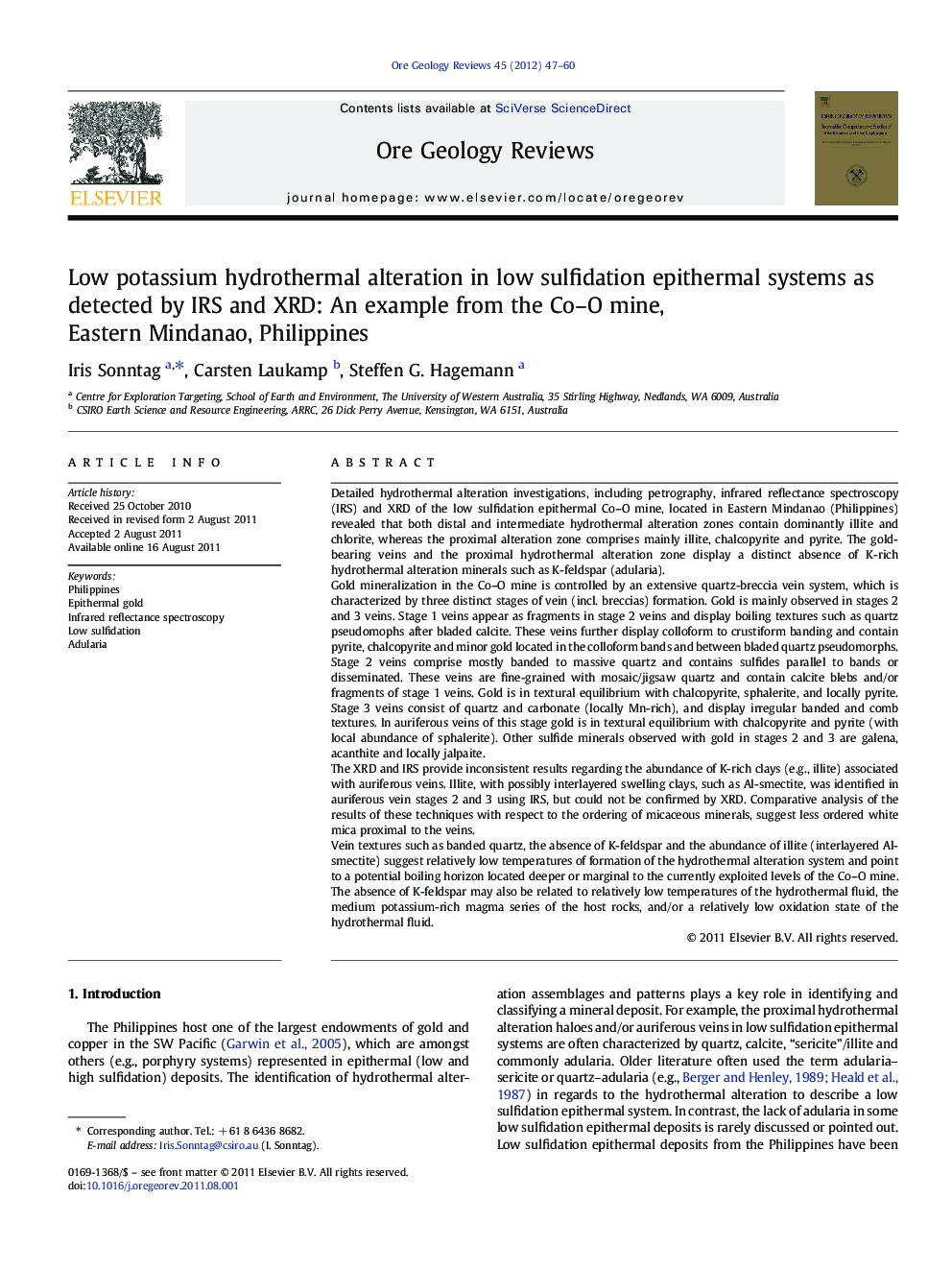| کد مقاله | کد نشریه | سال انتشار | مقاله انگلیسی | نسخه تمام متن |
|---|---|---|---|---|
| 4697711 | 1637258 | 2012 | 14 صفحه PDF | دانلود رایگان |

Detailed hydrothermal alteration investigations, including petrography, infrared reflectance spectroscopy (IRS) and XRD of the low sulfidation epithermal Co–O mine, located in Eastern Mindanao (Philippines) revealed that both distal and intermediate hydrothermal alteration zones contain dominantly illite and chlorite, whereas the proximal alteration zone comprises mainly illite, chalcopyrite and pyrite. The gold-bearing veins and the proximal hydrothermal alteration zone display a distinct absence of K-rich hydrothermal alteration minerals such as K-feldspar (adularia).Gold mineralization in the Co–O mine is controlled by an extensive quartz-breccia vein system, which is characterized by three distinct stages of vein (incl. breccias) formation. Gold is mainly observed in stages 2 and 3 veins. Stage 1 veins appear as fragments in stage 2 veins and display boiling textures such as quartz pseudomophs after bladed calcite. These veins further display colloform to crustiform banding and contain pyrite, chalcopyrite and minor gold located in the colloform bands and between bladed quartz pseudomorphs. Stage 2 veins comprise mostly banded to massive quartz and contains sulfides parallel to bands or disseminated. These veins are fine-grained with mosaic/jigsaw quartz and contain calcite blebs and/or fragments of stage 1 veins. Gold is in textural equilibrium with chalcopyrite, sphalerite, and locally pyrite. Stage 3 veins consist of quartz and carbonate (locally Mn-rich), and display irregular banded and comb textures. In auriferous veins of this stage gold is in textural equilibrium with chalcopyrite and pyrite (with local abundance of sphalerite). Other sulfide minerals observed with gold in stages 2 and 3 are galena, acanthite and locally jalpaite.The XRD and IRS provide inconsistent results regarding the abundance of K-rich clays (e.g., illite) associated with auriferous veins. Illite, with possibly interlayered swelling clays, such as Al-smectite, was identified in auriferous vein stages 2 and 3 using IRS, but could not be confirmed by XRD. Comparative analysis of the results of these techniques with respect to the ordering of micaceous minerals, suggest less ordered white mica proximal to the veins.Vein textures such as banded quartz, the absence of K-feldspar and the abundance of illite (interlayered Al-smectite) suggest relatively low temperatures of formation of the hydrothermal alteration system and point to a potential boiling horizon located deeper or marginal to the currently exploited levels of the Co–O mine. The absence of K-feldspar may also be related to relatively low temperatures of the hydrothermal fluid, the medium potassium-rich magma series of the host rocks, and/or a relatively low oxidation state of the hydrothermal fluid.
► Detailed hydrothermal alteration study of low sulfidation epithermal Co-O mine.
► Using infrared reflectance spectroscopy, XRD and vein paragenesis.
► Veins and alteration display low-K hydrothermal zones with lack of K-feldspar.
► Fluid of low temperature/ oxidation state or influence of host rocks composition.
► Sulfides indicate an intermediate-sulfidation state.
Journal: Ore Geology Reviews - Volume 45, June 2012, Pages 47–60